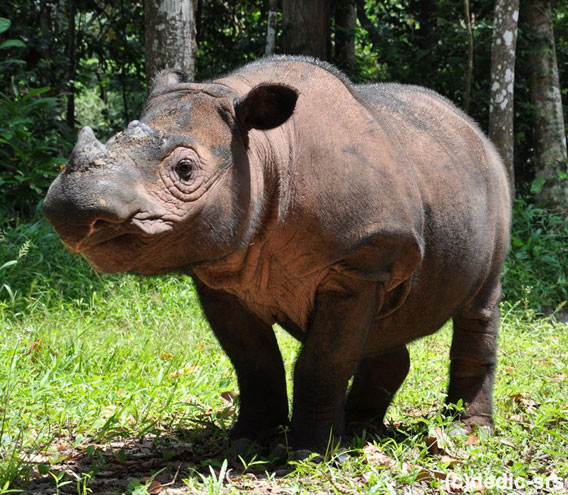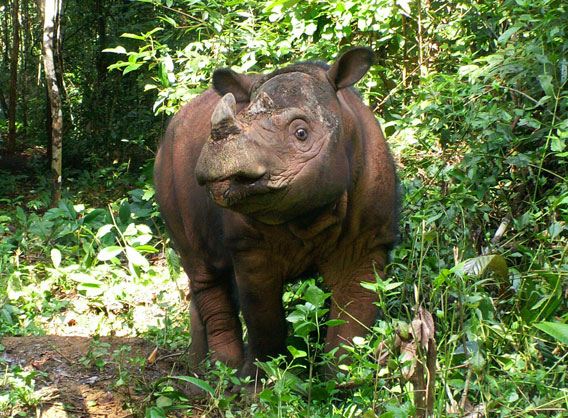
Conservationists hope Ratu, pictured above, has a successful third pregnancy. Photo by: International Rhino Foundation.
Ratu, a female Sumatra rhino (Dicerorhinus sumatrensis), is in the eleventh month of her third pregnancy raising hopes for a successful birth of one of the world’s most imperiled big mammals. Ratu suffered two prior miscarriages, but researchers believe the current pregnancy—which still has four to five months to go (for a total term of around 15-16 months)—could produce what Indonesian officials have long hoped for: a bundle of joy at the Sumatran Rhino Sanctuary in Sumatra. With only around 200 Sumatran rhinos surviving today in Indonesia and Bornean Malaysia, many conservationists see such breeding efforts as the last and best chance to save the Critically Endangered species from extinction.
The Sumatran Rhino Sanctuary, covering 250 acres in Way Kambas National Park, is currently home to four rhinos, three females and one male. The male and father-to-be, Andalas, is descended from the world’s only successful Sumatran rhino breeding program in Cincinnati Zoo in the U.S. As for Ratu, she had been roaming near villages just outside the park before she was moved to the sanctuary in a bid to save the species.
“We’ve got fingers crossed that everything will continue to go well and that Ratu will deliver a healthy baby sometime in late spring or early summer. This is truly a dedicated team effort, not just with regard to managing a critical pregnancy, but also in terms of the round-the-clock effort to protect Indonesia’s last remaining wild Sumatran rhinos,” Susie Ellis, executive director of the International Rhino Foundation (IRF) said in a press release.
Following the previous two miscarriages, Ratu has been given a daily hormone supplement that conservationists have seen success with in the past. She also has constant access to natural vegetation and mud wallows in the large sanctuary.
Vast deforestation in Malaysia and Indonesia—still ongoing—as well as targeting by poachers, has caused the Sumatran rhino to vanish almost entirely from their former range and hang-on by a thread in others. Rhinos are killed by poachers for their horns which is used in black-market traditional chinese medicine, although studies have shown that rhino horn has no medicinal value.
Today, however, one of the gravest threats to Sumatran rhinos is that populations, mostly in protected areas, are simply too small and scattered to survive in the long-term.
Conservationists in the Malaysian state of Sabah are hoping to begin a similar breeding effort for the Bornean rhino, a subspecies of the Sumatran rhino. The Borneo Rhino Alliance (BRA) currently has two Bornean rhinos in possible breeding condition.
Including the Sumatran rhino, two other rhino species are currently categorized as Critically Endangered by the IUCN Red List: the black (Diceros bicornis) and the Javan (Rhinoceros sondaicus). Less than 50 Javan rhinos survive, all in a single park in Java. Last year also marked the announcements of the extinction of two rhino subspecies: the Vietnamese rhino (Rhinoceros sondaicus annamiticus), a subspecies of the Javan, and the western black rhino (Diceros bicornis longipes), a subspecies of the black.

Father-to-be Andalas. Photo by: International Rhino Foundation.
Related articles
‘Christmas miracle’ for endangered rhinos
(12/24/2011) Conservationists and wildlife officials in the Malaysian state of Sabah airlifted a young female Sumatran Rhinoceros — one of the world’s most endangered animals — to an area of forest where she would encounter a potential partner, reports the Sabah Wildlife Department and Borneo Rhino Alliance. Sumatran Rhinoceros populations are so low, some individuals live in areas where they have no hope of ever finding another rhino.
Malaysia must take action to avoid extinction of its last rhinos
(11/05/2011) Malaysia must take immediate action to prevent the extinction of the handful of rhinos that survive on the island of Borneo, says a coalition of environmental groups.
How do we save the Sumatran rhino?

(06/06/2011) Some conservation challenges are more daunting than others. For example, how do you save a species that has been whittled down to just a couple hundred individuals; still faces threats such as deforestation, poaching and trapping; is notoriously difficult to breed in captivity; and is losing precious time because surviving animals are so few and far-apart that simply finding one another—let alone mating and successfully bringing a baby into the world—is unlikely? This is the uphill task that faces conservationists scrambling to save the Sumatran rhino (Dicerorhinus sumatrensis). A new paper in Oryx, aptly named Now or never: what will it take to save the Sumatran rhinoceros Dicerorhinus sumatrensis from extinction? analyzes the conservation challenge, while putting forth a number of recommendations.